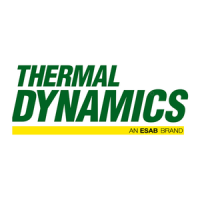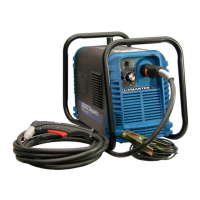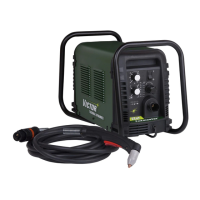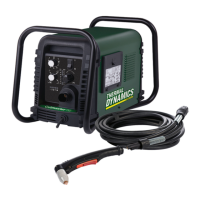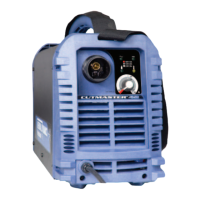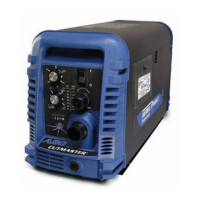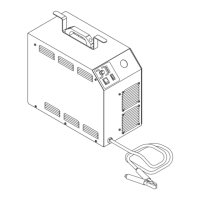TROUBLESHOOTING 4-2 Manual 0-2898
E. Dross
When dross is present on carbon steel, it is commonly
referred to as either 'high speed, slow speed, or top
dross'. Dross present on top of the plate is normally
caused by too great a torch to plate distance. 'Top
dross' is normally very easy to remove and can often
be wiped off with a welding glove. 'Slow speed dross'
is normally present on the bottom edge of the plate.
It can vary from a light to heavy bead, but does not
adhere tightly to the cut edge, and can be scraped off
easily. 'High speed dross' usually forms a narrow bead
along the bottom of the cut edge and is very difficult
to remove. When cutting a troublesome steel, it is
sometimes useful to reduce the cutting speed to pro-
duce 'slow speed dross'. Any resultant cleanup can
be accomplished by scraping, not grinding.
F. Common Cutting Faults
1. Insufficient Penetration
a. Cutting speed too fast
b. Torch tilted too much
c. Metal too thick
d. Worn torch parts
e. Cutting current too low
f. Non-Genuine Thermal Dynamics parts used
2. Main Arc Extinguishes
a. Cutting speed too slow
b. Torch standoff too high from workpiece
c. Cutting current too high
d. Work cable disconnected
e. Worn torch parts
f. Non-Genuine Thermal Dynamics parts used
3. Excessive Dross Formation
a. Cutting speed too slow
b. Torch standoff too high from workpiece
c. Worn torch parts
d. Improper cutting current
e. Non-Genuine Thermal Dynamics parts used
4. Short Torch Parts Life
a. Moisture in air source
b. Exceeding system capability (material too thick)
c. Excessive pilot arc time
d. Gas pressure too low
e. Improperly assembled torch
f. Incorrect torch parts for the operation
g. Non-Genuine Thermal Dynamics parts used
4.05 Troubleshooting Guide -
General Information
WARNING
There are extremely dangerous voltage and power
levels present inside this unit. Do not attempt to
diagnose or repair unless you have had training in
power electronics measurement and troubleshoot-
ing techniques.
A. General Information
The CutMaster
38 Operating Manual describes basic
troubleshooting and parts replacement procedures.
This Service Manual covers advanced troubleshooting,
which requires power supply disassembly and live mea-
surements. Advanced troubleshooting and repair of this
unit should be undertaken only by those familiar with
high voltage high power electronic equipment.
If major complex subassemblies are faulty, the faulty sub-
assembly must be returned for repair.
NOTE
Follow all instructions as listed and complete each
in the order presented.
The troubleshooting guide has subsections as follows:
Section 4.06 - Circuit Fault Isolation
Section 4.07 - Main Input and Internal Power Prob-
lems
Section 4.08 - Pilot Arc Problems
Section 4.09 - Main Arc Problems
Section 4.10 - Test Procedures
Subsection 4.10 includes specific test procedures, indica-
tions, and measurements. The subsection is referenced
by the troubleshooting guide for the specific test to be
performed.
